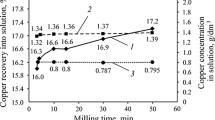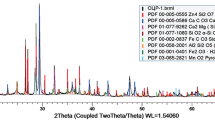Abstract
It is established that features of the composition and properties of copper sulfates essentially predetermine their flotation behavior. An effective technology for their processing, which makes it possible to obtain high beneficiation indicators due to regulation of the energy state the disperse system and subsequent weak electrochemical effects on the flotation pulp, is developed.
Similar content being viewed by others
References
G. A. Yurgenson, N. G. Smirnova, and L. A. Karenina, “On features of the mineralogy of the oxidation zone of the Udokan copper deposit,”Vestn. Nauchn. Inform. Zabaikalskogo Filiala Geogr. Obshch. SSSR, No. 9 (1968).
G. A. Yurgenson, “On the unconventional brochantites of the Udokan copper deposit,”Zap. Vsesoyuz. Mineral. Obshch., No. 1 (1973).
G. A. Yurgenson, “Oxidation zone in permanently frozen rocks,”Zap. Vsesoyuz. Mineral. Obshch., No. 5 (1979).
L. F. Narkelyun, Yu. P. Bezrodnykh, A. I. Trubachev, and G. A. Yurgenson, “Features of geology and questions concerning the genesis of the Udokan deposit of copper-containing sandstones,” in:Geology of Certain Ore Deposits of Trans-Baikal [in Russian], Chita (1968).
F. P. Krendelev, I. N. Bakun, and R. N. Volodin,Copper-Containing Sandstones of Udokan [in Russian], Nauka, Moscow (1983).
B. S. Nai, L. M. Glotov, L. I. Nikonova, et al., “Substance composition and varieties of Udokan ore,” in:Mining and Processing of Ores of Rare, Nonferrous, and Noble Metals [in Russian], No. 13, Nauka, Moscow (1965).
G. A. Yurgenson, “Features of the mineralogy and formation of an oxidation zone in permanently frozen rocks,” in:Problems of Ore Formation, Prospecting, and Estimation of Mineral Resources [in Russian], Izdatelstvo Sibirskogo Otdeleniya Rossiiskoi Akademii Nauk, Novosibirsk (1996).
L. F. Narkelyun, A. I. Trubachev, V. S. Salikhov, et al.,Oxidized Ores of Udokan [in Russian], Nauka, Novosibirsk (1987).
N. M. Bazanova, D. V. Sologub, L. A. Larionov, et al., “Semi-industrial testing of mixed and oxidized copper ores from the Udokan deposit,”Tsvet. Metall., No. 5 (1981).
N. M. Bazanova, “Beneficiation of ores from the Udokan deposit,”Tsvet. Metall., No. 12 (1975).
L. G. Slobuyev, D. V. Sologub, G. P. Giganov, and M. A. Vinogradova, “Development of combined schemes for processing of copper ores from the Udokan deposit,”Tsv. Metally, No. 7 (1985).
J. D. Dana, E. S. Dana, Ch. Pelach, et al.,Mineralogy System [Russian translation], Vol. 2, Half Volume 1, Inostrannaya Literatura, Moscow (1953).
V. A. Chanturiya and R. Sh. Shafeyev,Chemistry of Surface Phenomena During Flotation [in Russian], Nauka, Moscow (1977).
A. V. Fatyanov and K. A. Nikiforov,Intensification of Copper-Ore Flotation [in Russian], Nauka, Novosibirsk (1993).
Additional information
State Technical University, Chita, Russia; and Institute of Natural Resources, Siberian Branch, Russian Academy of Sciences, Chita, Russia. Translated from Fiziko-Tekhnicheskie Problemy Razrabotki Poleznykh Iskopaemykh, No. 2, pp. 104–112, March–April, 2000.
Rights and permissions
About this article
Cite this article
Fatyanov, A.V., Yurgenson, G.A. & Glotova, Y.V. Effect of features of the mineral composition and conditions of formation of oxidized copper ores of the udokan deposit on their beneficiation technology. J Min Sci 36, 185–193 (2000). https://doi.org/10.1007/BF02551799
Received:
Issue Date:
DOI: https://doi.org/10.1007/BF02551799




